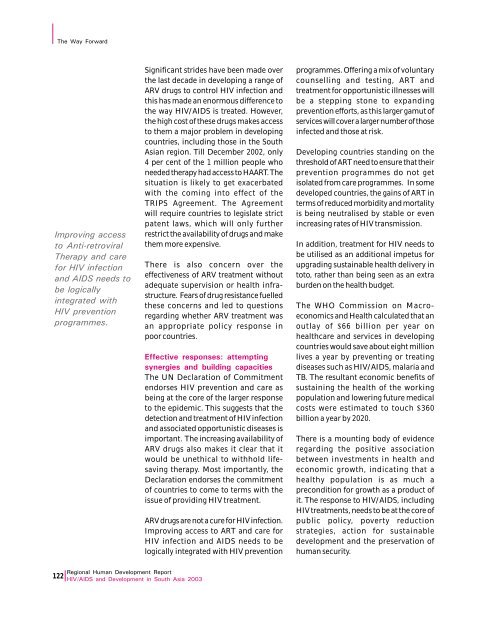Download Report - UNDP Asia-Pacific Regional Centre - United ...
Download Report - UNDP Asia-Pacific Regional Centre - United ...
Download Report - UNDP Asia-Pacific Regional Centre - United ...
Create successful ePaper yourself
Turn your PDF publications into a flip-book with our unique Google optimized e-Paper software.
The Way orwardImproving accessto Anti-retroviralTherapy and carefor HIV infectionand AIDS needs tobe logicallyintegrated withHIV preventionprogrammes.Significant strides have been made overthe last decade in developing a range ofARV drugs to control HIV infection andthis has made an enormous difference tothe way HIV/AIDS is treated. However,the high cost of these drugs makes accessto them a major problem in developingcountries, including those in the South<strong>Asia</strong>n region. Till December 2002, only4 per cent of the 1 million people whoneeded therapy had access to HAART. Thesituation is likely to get exacerbatedwith the coming into effect of theTRIPS Agreement. The Agreementwill require countries to legislate strictpatent laws, which will only furtherrestrict the availability of drugs and makethem more expensive.There is also concern over theeffectiveness of ARV treatment withoutadequate supervision or health infrastructure.Fears of drug resistance fuelledthese concerns and led to questionsregarding whether ARV treatment wasan appropriate policy response inpoor countries.Effective responses: attemptingsynergies and building capacitiesThe UN Declaration of Commitmentendorses HIV prevention and care asbeing at the core of the larger responseto the epidemic. This suggests that thedetection and treatment of HIV infectionand associated opportunistic diseases isimportant. The increasing availability ofARV drugs also makes it clear that itwould be unethical to withhold lifesavingtherapy. Most importantly, theDeclaration endorses the commitmentof countries to come to terms with theissue of providing HIV treatment.ARV drugs are not a cure for HIV infection.Improving access to ART and care forHIV infection and AIDS needs to belogically integrated with HIV preventionprogrammes. Offering a mix of voluntarycounselling and testing, ART andtreatment for opportunistic illnesses willbe a stepping stone to expandingprevention efforts, as this larger gamut ofservices will cover a larger number of thoseinfected and those at risk.Developing countries standing on thethreshold of ART need to ensure that theirprevention programmes do not getisolated from care programmes. In somedeveloped countries, the gains of ART interms of reduced morbidity and mortalityis being neutralised by stable or evenincreasing rates of HIV transmission.In addition, treatment for HIV needs tobe utilised as an additional impetus forupgrading sustainable health delivery intoto, rather than being seen as an extraburden on the health budget.The WHO Commission on Macroeconomicsand Health calculated that anoutlay of $66 billion per year onhealthcare and services in developingcountries would save about eight millionlives a year by preventing or treatingdiseases such as HIV/AIDS, malaria andTB. The resultant economic benefits ofsustaining the health of the workingpopulation and lowering future medicalcosts were estimated to touch $360billion a year by 2020.There is a mounting body of evidenceregarding the positive associationbetween investments in health andeconomic growth, indicating that ahealthy population is as much aprecondition for growth as a product ofit. The response to HIV/AIDS, includingHIV treatments, needs to be at the core ofpublic policy, poverty reductionstrategies, action for sustainabledevelopment and the preservation ofhuman security.<strong>Regional</strong> Human Development <strong>Report</strong>122 HIV/AIDS and Development in South <strong>Asia</strong> 2003
















